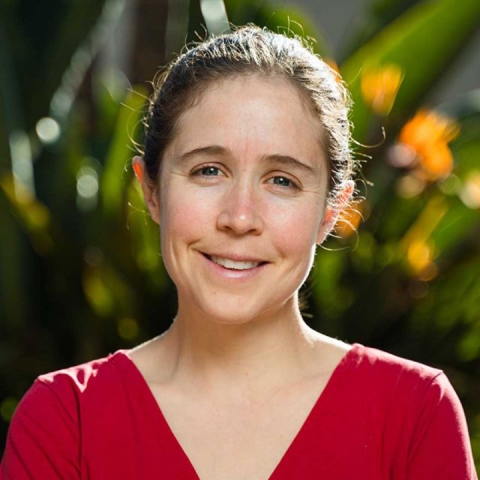
UC Santa Barbara faculty members Anna Trugman and Gen Li have earned prestigious early-career awards from the American Geophysical Union (AGU).
Trugman has earned AGU’s 2025 James B. Macelwane Medal. This honor “recognizes significant contributions to the Earth and space science by an outstanding early career scientist” and includes induction into the AGU College of Fellows.
Meanwhile, the AGU bestowed Li with the Luna B. Leopold Early Career Award and selected him for the Robert Sharp Lectureship. The Leopold Award is presented to a researcher within ten years of receiving their Ph.D. who has made outstanding contributions that advance the field of Earth and planetary surface processes. Li will deliver the Robert Sharp Lecture at the AGU’s annual meeting this December in New Orleans.
“We are thrilled for Professors Trugman and Li,” said Rachel A. Segalman, vice chancellor for research. “Not only is this a well deserved recognition of each of their scientific contributions, it is also an important recognition of UCSB’s culture of embracing scientific innovation and discovery.”
Seeing the forest and the trees
“The Macelwane Medal is really a team award that is reflective of the hard work of my lab group,” said Trugman, a faculty member in the Department of Geography. “I’ve also benefited hugely from collaborations with scientists across the U.S. and internationally, as well as many mentors, including the team involved in nominating me.”
“The Macelwane Medal is the highest early-career award within AGU and the greatest honor an early career scholar can achieve in the field of Earth and environmental sciences,” explained Kelly Caylor, associate vice chancellor for research in Earth, environmental and sustainability sciences. “Professor Scott Jasechko received this medal in 2022; it is a testament to the excellence of our faculty that we now have two medalists in the past four years.”
Trugman studies the physiological and ecological processes that determine how plants will respond to a world with elevated CO2 and the associated climate changes. Her group uses in-situ measurements of plant physiology, tractable theoretical models to build upon ecological theory, and more complex mathematical models of vegetation to identify key ecological mechanisms. All these insights contribute to larger models that scientists use to make predictions about the terrestrial carbon cycle.
“Plants are the foundation of life on Earth and are a vital component in the global carbon cycle,” she said. As a result, terrestrial ecosystems, and particularly forests, have a great potential for mitigating human-induced climate change.
However, the fate of forests in the 21st century is highly uncertain. Trugman’s group tackles this uncertainty by producing frameworks for predicting and adapting to rapid climate change. For instance, much of her group’s research focuses on forest ecosystems in the western US — California in particular — that are vulnerable to drought and wildfire driven mortality.
Some of the specific applications the group works on include collaborations with academic colleagues and the National Park Service in Sequoia and Kings Canyon to develop drought risk assessments for mature Sequoia groves and understand the recruitment of seedlings after fires. This research will inform adaptive management and interventions to promote the resilience of the giant sequoias, which are now threatened by the very wildfires they evolved to live alongside. Megafires have wiped out more than 15% of the venerable trees since 2020.
Trugman’s work also finds applications in climate change mitigation. With society hurtling past our net warming targets, there’s been increased interest in solutions other than reducing emissions. While sequestering carbon in forests seems attractive, Trugman’s research has revealed that current standards are not sufficient to guarantee that these projects actually sequester and retain carbon. Her group continues to analyze these nature-based climate solutions to inform policy decisions.
Answering large question about a dynamic planet
“I am humbled and honored to receive the Luna B. Leopold Early Career Award from AGU and to present the Robert Sharp Lecture at AGU this year,” said Li, a faculty member in the Earth Science Department. “I am grateful to my mentors, collaborators, colleagues, and group members for their support, and share this award with them.” Geography professor Vamsi Ganti won the Leopold Award in 2015, Li noted, making UCSB the only university with more than one Leopold awardee.
Li studies erosion and weathering — the natural processes that break down rocks and transport sediment. These processes play many important roles on our planet by circulating materials and chemicals within the Earth. They shape landscapes, like mountains and floodplains, and regulate the carbon cycle and Earth's climate. They help soils form, liberate nutrients from rocks and generate devastating natural hazards, like landslides.
Through theory, fieldwork, modeling and remote sensing, Li aims to build a better understanding of the drivers and impacts of these processes. He’s particularly interested in the interplay between tectonics, erosion, the carbon cycle and the climate. He hopes to contribute to a fuller account of how these interactions shape Earth's surface environment, both today and in the geological past.
And Li has his sights on mighty large questions. For instance, his group is working on tropical mountainous islands to reveal how plate tectonics and weathering at low latitudes drove global cooling and ice ages in the geologic past. Meanwhile, his research on landslides in the Himalayan-Tibetan Range, suggests that the hazards caused by megaquakes may last long after the ground has settled. What’s more, it has offered insights into the fundamental question of how earthquakes build mountains.





